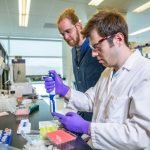A maker space is a community space in a school or other gathering place where students are able to take part in hands-on learning in creative ways. They are called maker spaces because they provide opportunities for students to design, create, manufacture, and invent new things. They are usually housed in school libraries or other community spaces.
Some would argue that the seeds of the maker space movement have been in existence forever, but the official idea emerged in 2005 after Make: magazine launched. The magazine was founded by Dale Dougherty, and is published bimonthly on their website, which serves as an online community of DIY “makers.”
Contents
Contributors
- Dale Dougherty
Key Concepts
Equipment
Most maker spaces are equipped with a variety of tools that can be used for designing and creating things. Some of these tools can include arts and crafts supplies like clay, pipe cleaners, paint, popsicle sticks, cardboard, paper, and glue. Other times, they are more industrial, including nuts and bolts or supplies for mechanical or robotic work.
3D printers
Some maker spaces are equipped with 3D printers and computers. On the computer, students are able to use software like Tinker CAD or other programs to design a three-dimensional object and print it from the bottom up in hard plastic. This teaches students about design thinking in a way that is more related to the STEM fields.
Purpose
Maker spaces are a unique opportunity for student engagement in that they promote design thinking and increase access to educational materials. By operating as a community space, they function as educational centers, gathering places, and creative studios all in one. And by including a variety of creative materials, they are accessible to individuals across a range of ages and abilities.
Additionally, maker spaces facilitate student learning through their use of play, and in doing so, are able to present STEM subjects in a less threatening way. In doing so, they are able to attract students who are underrepresented in these fields and engage students who may be struggling in these subjects.
Student empowerment and learning
Maker spaces can have a powerful effect on a student’s self confidence and self-efficacy while they express their creativity and learn new skills. They provide a necessary outlet for children to play while also offering an opportunity for educational engagement. So-called “maker education” encourages curiosity, inquiry, and leads students to be better collaborators and confident learners. They become more independent, learn the value of perseverance, and master creative problem solving.
Establishing a maker space
Setting up a new maker space in your school or community is simpler than it sounds. The four most important elements (in order) are creativity, community, and resources.
While big-ticket items like a 3D printer may seem attractive, they can also be expensive, and a cart full of crafting items from the hobby store can add up fast. Maker spaces are also committed to recycling and reusing as many materials as possible, so try to utilize donated items as often as you can. This will not only save your budget if you do want to add a STEM tool later on, it will also promote sustainability and reduce waste.
Additional Resources and References
Resources
References
- Bowler, L. (2014). Creativity through” maker” experiences and design thinking in the education of librarians. Knowledge Quest, 42(5), 58.
- Loertscher, D. V. (2012). Maker spaces and the learning commons. Teacher Librarian, 40(1), 45.
- Michele Moorefield-Lang, H. (2014). Makers in the library: case studies of 3D printers and maker spaces in library settings. Library Hi Tech, 32(4), 583-593.

